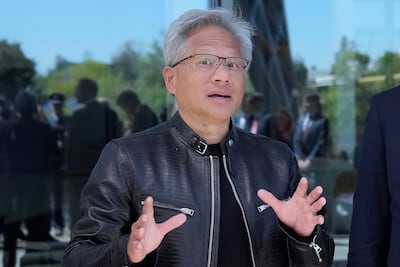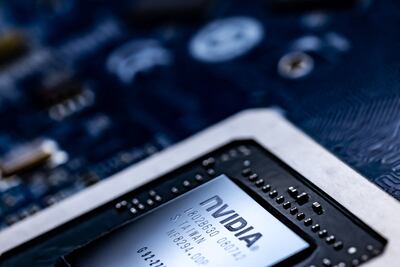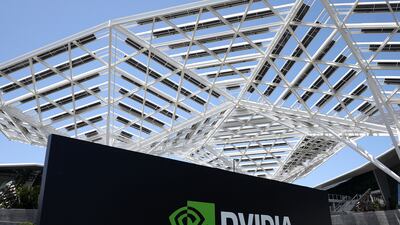Chip maker Nvidia predicted a bullish sales outlook for the second quarter and announced a 10-for-one forward stock split, impressing investors and demonstrating that investment in artificial intelligence computing continues to be robust.
Industry analysts consider the stock split to be a move to attract even more investors, after the company’s market value almost tripled over the past year due to increasing enthusiasm for AI.
The California-based company said each holder of common stock, as of market close on June 6, will receive nine additional shares of common stock.
Shares will start trading on a split-adjusted basis when the market opens on June 10.
“Shareholder support will be crucial,” Thomas Monteiro, senior analyst at Investing.com, told The National.
"While the splits should create further momentum for the stock itself in the short run, they are not nearly as important as the improved guidance on the fundamental front."
Why the stock split is significant for Nvidia
Splitting stocks is a tactic companies use to make it less expensive to buy individual shares. It does not alter a company's financial fundamentals.
This can attract retail investors who make small trades.
In 2022, technology companies Alphabet, Amazon and Tesla also announced splits to reduce the price of their shares.
Nvidia's stock is one of the best performers in the S&P 500 index, which has jumped nearly 12 per cent since the start of the year.
Its shares closed 0.46 per cent down at $949.50 on Wednesday, giving the company a market value of $2.34 trillion.
With a 10-for-one split at that price, one share of Nvidia will cost $94.95, but an investor would need to buy 10 shares to maintain the same ownership stake in the company.
After the earnings announcement and disclosure of new plans, the stock jumped more than 6 per cent in after-market hours to trade at almost $1,007.
The company's shares have surged more than 97 per cent since the start of the year.
Nvidia’s improved second-quarter outlook
Nvidia said it expected revenue of $28 billion, plus or minus 2 per cent, in this quarter, compared to the $26.6 billion forecast by LSEG analysts.
In the first quarter, which ended on April 28, Nvidia reported revenue of $26.04 billion, up 18 per cent from the previous quarter and up 262 per cent on an annual basis. It surpassed expectations of $24.65 billion.
Net income during the period surged 628 per cent yearly to almost $14.9 billion. Earnings for each share stood at $5.98 compared to $0.82 in the period for 2023.
It was the company’s fourth consecutive quarter with more than $10 billion in revenue.
What are Nvidia's growth drivers?
Nvidia’s strong performance in the last quarter was primarily driven by its data centre business that makes chips used to build and run generative AI technology such as ChatGPT.
The division’s first-quarter revenue stood at a record $22.6 billion, up 427 per cent from a year ago.
Nvidia designs and makes AI hardware and software GPUs for various industries. GPUs can process various tasks simultaneously, making them useful for machine learning, video editing and gaming applications.
The company’s gaming unit brought in nearly $2.6 billion, up 18 per cent from the same quarter a year ago, in the February-April period.
Before its AI chips gained momentum, Nvidia primarily focused on gaming graphics cards. Now, some of its graphics cards are used for AI purposes.
Why market analysts are optimistic about Nvidia
Numbers remain “incredibly strong”, leaving no doubt that the company's leadership in the AI revolution remains unchallenged for now, Mr Monteiro said.
“Against a backdrop of increasing competition and projected self-reliance on the chip space for big tech, both profitability and guidance indicate that growing demand in all areas should more than make up for the challenges in the rest of the year,” he said.
The positive outlook solidifies Nvidia’s position as the leading beneficiary of AI investment.
Its AI accelerators, which are chips that assist global companies and data centres in developing AI chatbots, have become highly sought in recent years.
AI will bring “significant productivity gains” to nearly every industry and help companies be more cost and energy efficient while expanding revenue opportunities, said Jensen Huang, founder and chief executive of Nvidia.
“The next Industrial Revolution has begun,” he said.
“Companies and countries are partnering with Nvidia to shift the trillion-dollar traditional data centres to accelerated computing and build a new type of data centre – AI factories – to produce a new commodity: artificial intelligence.”
In the past few quarters, Nvidia sales have jumped as technology companies such as Meta, Amazon, OpenAI and Microsoft bought its GPUs.
“A big highlight this quarter was Meta’s announcement of Lama 3, their latest large-language model, which used [Nvidia’s] 24,000 H100 GPUs,” Colette Kress, Nvidia's chief financial officer, said during an analyst call.
Squid Game season two
Director: Hwang Dong-hyuk
Stars: Lee Jung-jae, Wi Ha-joon and Lee Byung-hun
Rating: 4.5/5
UAE currency: the story behind the money in your pockets
ALRAWABI%20SCHOOL%20FOR%20GIRLS
%3Cp%3ECreator%3A%20Tima%20Shomali%3C%2Fp%3E%0A%3Cp%3EStarring%3A%C2%A0Tara%20Abboud%2C%C2%A0Kira%20Yaghnam%2C%20Tara%20Atalla%3C%2Fp%3E%0A%3Cp%3ERating%3A%204%2F5%3C%2Fp%3E%0A
Mercer, the investment consulting arm of US services company Marsh & McLennan, expects its wealth division to at least double its assets under management (AUM) in the Middle East as wealth in the region continues to grow despite economic headwinds, a company official said.
Mercer Wealth, which globally has $160 billion in AUM, plans to boost its AUM in the region to $2-$3bn in the next 2-3 years from the present $1bn, said Yasir AbuShaban, a Dubai-based principal with Mercer Wealth.
“Within the next two to three years, we are looking at reaching $2 to $3 billion as a conservative estimate and we do see an opportunity to do so,” said Mr AbuShaban.
Mercer does not directly make investments, but allocates clients’ money they have discretion to, to professional asset managers. They also provide advice to clients.
“We have buying power. We can negotiate on their (client’s) behalf with asset managers to provide them lower fees than they otherwise would have to get on their own,” he added.
Mercer Wealth’s clients include sovereign wealth funds, family offices, and insurance companies among others.
From its office in Dubai, Mercer also looks after Africa, India and Turkey, where they also see opportunity for growth.
Wealth creation in Middle East and Africa (MEA) grew 8.5 per cent to $8.1 trillion last year from $7.5tn in 2015, higher than last year’s global average of 6 per cent and the second-highest growth in a region after Asia-Pacific which grew 9.9 per cent, according to consultancy Boston Consulting Group (BCG). In the region, where wealth grew just 1.9 per cent in 2015 compared with 2014, a pickup in oil prices has helped in wealth generation.
BCG is forecasting MEA wealth will rise to $12tn by 2021, growing at an annual average of 8 per cent.
Drivers of wealth generation in the region will be split evenly between new wealth creation and growth of performance of existing assets, according to BCG.
Another general trend in the region is clients’ looking for a comprehensive approach to investing, according to Mr AbuShaban.
“Institutional investors or some of the families are seeing a slowdown in the available capital they have to invest and in that sense they are looking at optimizing the way they manage their portfolios and making sure they are not investing haphazardly and different parts of their investment are working together,” said Mr AbuShaban.
Some clients also have a higher appetite for risk, given the low interest-rate environment that does not provide enough yield for some institutional investors. These clients are keen to invest in illiquid assets, such as private equity and infrastructure.
“What we have seen is a desire for higher returns in what has been a low-return environment specifically in various fixed income or bonds,” he said.
“In this environment, we have seen a de facto increase in the risk that clients are taking in things like illiquid investments, private equity investments, infrastructure and private debt, those kind of investments were higher illiquidity results in incrementally higher returns.”
The Abu Dhabi Investment Authority, one of the largest sovereign wealth funds, said in its 2016 report that has gradually increased its exposure in direct private equity and private credit transactions, mainly in Asian markets and especially in China and India. The authority’s private equity department focused on structured equities owing to “their defensive characteristics.”
Dirham Stretcher tips for having a baby in the UAE
Selma Abdelhamid, the group's moderator, offers her guide to guide the cost of having a young family:
• Buy second hand stuff
They grow so fast. Don't get a second hand car seat though, unless you 100 per cent know it's not expired and hasn't been in an accident.
• Get a health card and vaccinate your child for free at government health centres
Ms Ma says she discovered this after spending thousands on vaccinations at private clinics.
• Join mum and baby coffee mornings provided by clinics, babysitting companies or nurseries.
Before joining baby classes ask for a free trial session. This way you will know if it's for you or not. You'll be surprised how great some classes are and how bad others are.
• Once baby is ready for solids, cook at home
Take the food with you in reusable pouches or jars. You'll save a fortune and you'll know exactly what you're feeding your child.
Company%20profile%20
%3Cp%3E%3Cstrong%3EName%3A%20%3C%2Fstrong%3EElggo%3Cbr%3E%3Cstrong%3EStarted%3A%3C%2Fstrong%3E%20August%202022%3Cbr%3E%3Cstrong%3EFounders%3A%3C%2Fstrong%3E%20Luma%20Makari%20and%20Mirna%20Mneimneh%3Cbr%3E%3Cstrong%3EBased%3A%3C%2Fstrong%3E%20Dubai%2C%20UAE%3Cbr%3E%3Cstrong%3ESector%3A%3C%2Fstrong%3E%20Education%20technology%20%2F%20health%20technology%3Cbr%3E%3Cstrong%3ESize%3A%3C%2Fstrong%3E%20Four%20employees%3Cbr%3E%3Cstrong%3EInvestment%20stage%3A%3C%2Fstrong%3E%20Pre-seed%3C%2Fp%3E%0A




